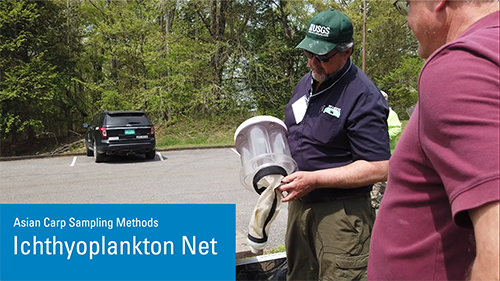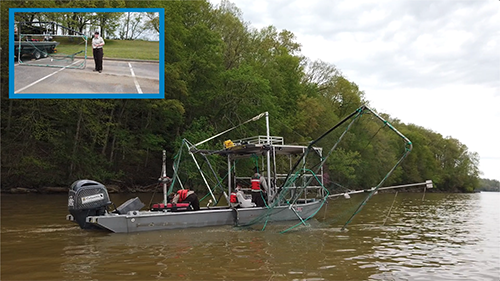Invasive fish genetics project ignites passion for field work
By Hope Dzik, Freshwater Collaborative summer research student
This summer, 35 undergraduate students from across the country conducted research with Freshwater@UW, the University of Wisconsin’s cross-site, cross-discipline research opportunities program. Freshwater@UW is supported by the Freshwater Collaborative, Wisconsin Sea Grant, Water@UW–Madison, the Water Resources Institute and the University of Wisconsin–Madison Graduate School. In the final weeks of the program, students reflected on what they learned. Here’s Hope Dzik, an undergraduate sophomore in environmental biology and plant biology from the Michigan State University, who worked with Amy Workman at UW–Madison.

Dzik holds a water sample from Wisconsin River at Upham Woods. Image credit: Amy Workman
I applied to the Freshwater@UW Program in hopes of getting a deeper understanding of aquatic invasive species research. I was extremely excited for the opportunity to experience the process of field work. I’d not been able to do that at my home university.
When I found out I was accepted, I was both anxious and excited to meet everyone else involved in the Freshwater@UW Program. My experience with meeting other cohort members, grad students, professors and many others involved was one of the best parts of my summer. I made so many professional connections and met future environmental scientists from around the country.
Our orientation events allowed us to become acquainted with Madison and each other — the best part was pulling out invasive plants together and sitting exhausted in the shade afterward. Madison is also an amazing place during summer. I loved biking around the city on my free bike (shoutout to the Red Bicycle Project) and swimming in the lake.
Everyone involved in this program took time to get to know us, and I felt extremely taken care of. All the professionals I met, and the sense of community this program brought, made the stressful or confusing aspects of my research worth every mosquito bite or failed experiment.

Dzik takes a water sample for invasive carp DNA testing. Image credit: Amy Workman
My project objective was to refine a protocol for collection and analysis of invasive carp eDNA. Bighead and silver carp can indirectly harm native fish populations and are threats to Wisconsin’s fresh water, so being able to detect a population of either species in a body of water can aid in monitoring the growth of their population. I worked with both Upham Woods Outdoor Learning Center and the University of Wisconsin Biotechnology Center. My method development was a frustrating but gratifying process. It involved finding the best way to collect river samples from the Upham Woods campus, developing the most efficient way to extract DNA, and refining techniques to analyze the DNA samples. The complete protocol will be used for teaching high school groups, which is one of the reasons I selected this project. I wanted to show that biological research isn’t intimidating and is open to all types of people.
This project was an amazing opportunity; it allowed me to learn important skills like science communication and self-advocacy. I discovered how much I enjoy field biology and ecology while applying course concepts. The water collection process was a great experience, and I loved being outside in the river. Grad school does not seem as intimidating anymore, either. I arrived at Madison this summer questioning my post-undergraduate plans, and now I have started to plan my future in biological research. It has allowed me to narrow my career goals, and I hope to continue field research in the future.
The post Invasive fish genetics project ignites passion for field work first appeared on Wisconsin Sea Grant.Blog | Wisconsin Sea Grant
https://www.seagrant.wisc.edu/blog/invasive-fish-genetics-project-ignites-passion-for-field-work/


